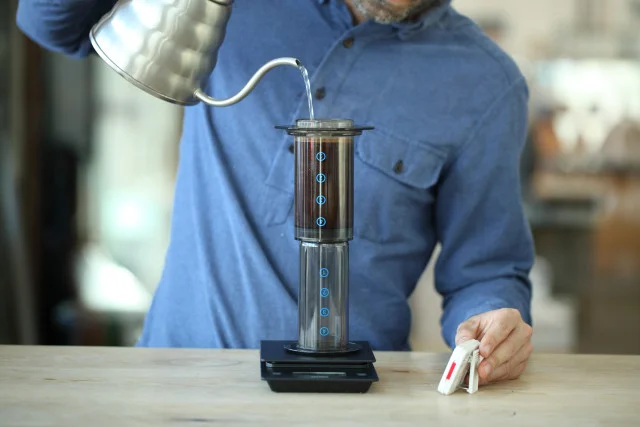How to Brew: AeroPress Edition
Three simple coffee experiments to try with your AeroPress coffee maker
If there was ever a person who achieved a harmonious balance of playfulness and practicality in design, it’s Alan Adler. His most popular invention, the Aerobie—conceived just 38 miles from our Oakland roastery—is a long-flying “superdisc” that broke Guiness World Records when it flew a distance of 1,333 feet. Following swiftly on the heels of that breakthrough was his other invention—one more applicable to us, perhaps—the AeroPress coffee maker.
A peculiar device for making coffee, AeroPress is a great travel companion because it’s so lightweight. It produces an exultant coffee that soars with focus and depth.
It’s also quite simple to use. For instance: You don’t need to worry about having a scale (the numbers on the outside of the device will help you measure) and you don’t need a kettle to guide your pour (the important thing is to fully immerse the grounds in water).
You can stick with the basics and get a lot of mileage out of your AeroPress, but you can also experiment with tools and techniques for countless variations on your morning cup.
Here are three ideas.
Filters
If you’re used to coffee from an automatic drip machine and then you try coffee from an AeroPress, you’ll notice thicker texture and more pronounced flavors. That’s due to the AeroPress microfilter, which yields a weighty coffee. Try using two filters instead of one for more clarity. Or, for a thicker, French press–like body, experiment with the metal filters made for AeroPress.
Water-to-coffee ratio
Due to its small size and the way it applies pressure to the coffee grounds, the AeroPress can easily create a concentrated coffee, approximate to an espresso. Adjust the water-to-coffee ratio to achieve your desired viscosity and depth. You can add hot water to create a modest AeroPress version of the classic Americano.
Inversion
As a cylindrical brewing device, AeroPress is intended to use a combination of gravity and manual force to press water through the ground coffee and the filter. If you like a little more precision and control, try inverting the device altogether before you begin.
This temporarily positions the filter at the top, keeping the grounds and water together without any possibility of coffee passing through the filter before you’re ready. The risk of this move is that you may accidentally spill very hot coffee on yourself, so practice with care.

